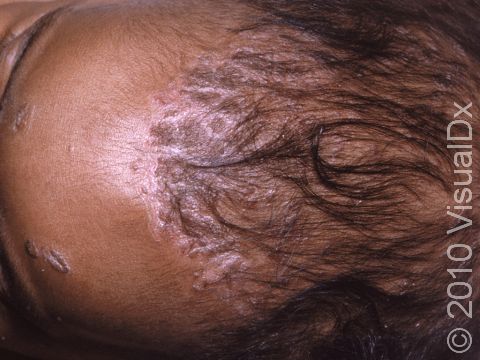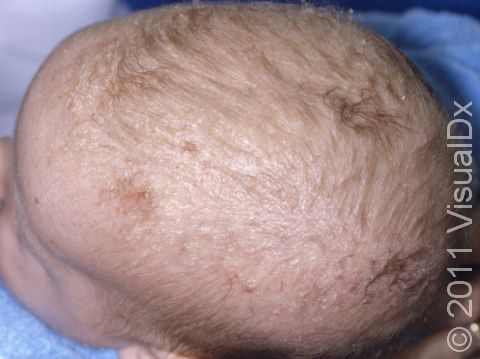Cradle Cap
Cradle cap is the common name for seborrheic dermatitis affecting the scalp of newborns. It is a very common skin disorder affecting the oil-rich parts of the skin, including the face, ears, and scalp, and it is often seen in babies up to 3 months of age. The skin becomes flaky and inflamed, and a yellowish scale can accumulate. If the scale is picked off, the skin underneath will look pink or red. Cradle cap itself is not serious, but the affected areas can become infected if not treated properly. The cause of cradle cap is related to overgrowth of normal skin yeast including Pityrosporum and Candida.
Who's At Risk?
Any baby can develop cradle cap. It is not a contagious condition, nor does it occur because of poor hygiene.
Signs & Symptoms
Cradle cap begins as a flaky scalp; it may then progressively worsen to a yellow scale layered on pink or red skin. The hair may become matted down in the scale. Babies may be itchy and may scratch at their heads or, more commonly, rub their heads or faces on surfaces. If the cradle cap becomes infected, it will ooze, scab, become increasingly red, or the baby might develop a fever.
Self-Care Guidelines
Cradle cap is easily treated; start by trying to gently remove some of the scale and flakiness by giving the baby a warm bath with gentle baby shampoo. If this is not sufficient, try loosening the scale before bath time by applying a bland oil, such as mineral oil, massaging it in and carefully combing and shampooing it out at bath time. Finally, you may try a shampoo designed for dandruff in adults, such as one with salicylic acid or selenium sulfide, although you should discuss this with your baby’s doctor before attempting it if the baby is younger than 3 months. Additionally, if you do try adult dandruff shampoo on the baby, be very careful to not get any shampoo in his/her eyes.
Treatments
The baby’s doctor may recommend a stronger antifungal shampoo or an antifungal cream. If the area is infected, he/she will prescribe antibiotics. If the area is very inflamed, the doctor may prescribe a steroid cream.
Visit Urgency
You should see your child’s doctor if the cradle cap does not improve with the self-care measures described above. Be sure to call the doctor if the cradle cap looks red, oozes, has excessive crusting, or if the baby has fever coupled with the previously described symptoms.
Trusted Links
References
Weston, William L., ed. Color Textbook of Pediatric Dermatology, pp 350. Mosby, 1996.
Freedberg, Irwin M, et al, ed. Fitzpatrick’s Dermatology in General Medicine, 6th Ed., pp 1198-1199. The McGraw-Hill Companies, Inc., 2003.
Habif, Thomas P., ed. Clinical Dermatology A Color Guide to Diagnosis and Therapy, pp 214-215. Mosby, 1996.
Last modified on October 5th, 2022 at 7:14 pm

Not sure what to look for?
Try our new Rash and Skin Condition Finder

